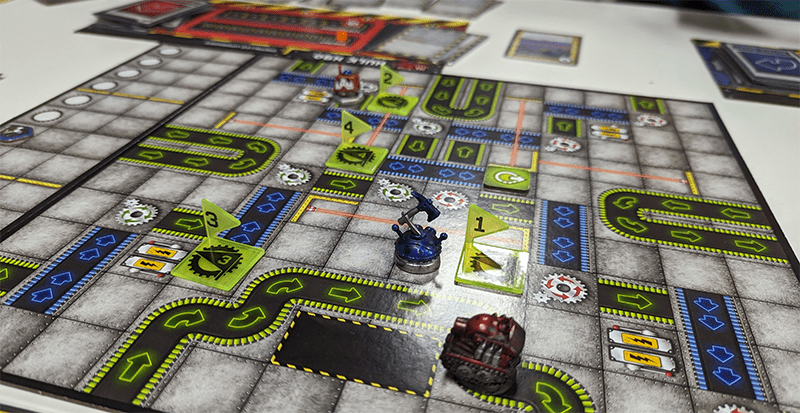Disclosure: Meeple Mountain received a free copy of this product in exchange for an honest, unbiased review. This review is not intended to be an endorsement.
Board game remakes are having a moment right now. It seems like every publisher is raiding the tombs of titles that have been gathering dust for over a decade and giving them a fresh new look. The 1990s in particular saw a boom in board game releases, with publishers like Avalon Hill putting out many popular games. One such title was Robo Rally, a robot-themed racing game. After lying dormant for years, Renegade Games has resurrected Robo Rally using the services of lawyers and necromancers. They plan to revive several other classic Avalon Hill games in similar fashion, refreshing these titles for a new generation of players.
Robo Rally is a board game that has flown under the radar for many years, but its premise is easily grasped. You and your friends are all robots in a factory. When the workday ends and the humans go home, these robots come alive and decide to have some fun by racing each other around the factory floor after hours by going to checkpoints in a specific order. With lasers, conveyor belts, rotating gears, and bottomless pits littering the makeshift race courses, you can see where the chaos can ensue, assuming OSHA doesn’t get involved.
All of this sounds pretty good until you realize you are all robots. Robots lack human judgment and flexibility: they simply follow protocols, even if inefficient. This is important because you’ll have to program their movements and watch the consequences of your bad decisions unfold before you. You will tell them to rotate left or right. You will tell them to move two spaces ahead. You will watch them fall into a pit as they loyally follow your every command because Phil pushed you two spaces in the wrong direction.
Not a serious game
I am mentioning all of this now because we are in the age of board gaming where people are looking for “sophisticated gameplay” from their colorful cardboard boxes. Meanwhile, Robo Rally here brings a kegger and beer funnels, despite being almost 30 years old. It doesn’t care about being a “normal” board game. It knows it’s stupid and doesn’t just want you to acknowledge it, but embrace it.
And it is easy to embrace because the rules aren’t pretentious. Most of the game is either done simultaneously or hands-off, meaning players don’t have to worry about executing complicated rules. This isn’t a mindless game, as the game will respect your decisions; it’s just not the focal point here.
To demonstrate this, let me give you the abridged version of the rules. The first thing that you all do in a round is the Upgrade Phase. At the start of the game, you have three uninstalled upgrade cards and 3 energy. From here, you decide whether to spend your energy to install these upgrades or draw new ones, hoping for better options. These upgrade cards bend the rules of the game, such as allowing you to move over pits or damaging robots by ramming into them. Once everyone has made their decisions, it’s time for the Programming Phase.
You start this phase by drawing 9 cards from your personal movement deck, and with these new cards, you program 5 of them in numbered slots, or registers as the game calls them. The cards aren’t that hard to figure out, as they give you basic directions like rotate left, back up, or move forward 3 spaces. After everyone has programmed their cards, it’s time to execute them, starting with the Priority Player, aka the first player.

Observe your failures, one step at a time
Gameplay in Robo Rally unfolds through revealing and executing the program cards. First, each player reveals their first card and carries out that programmed action, going in turn order. After everyone executes their first card, the game board activates – conveyor belts shift robots, lasers fire, and pushers shove any robots in their path. This is where carefully plotted moves can go awry. If a robot gets pushed by another robot or board element, it doesn’t matter if there are multiple robots lined up—they all get pushed together in a chain reaction. Players then continue revealing and executing their remaining cards, with the board activating again after each card phase. Do this for all five cards, and the round is over.
The only complicated part of Robo Rally, if I could even call it that, is the damage system. Besides the board itself, each robot also has their own laser that they fire in the direction they are facing. These lasers have unlimited range but only hit the first robot they can see. If you take a point of damage, you draw from the damage deck, and the damage comes in two flavors.
SPAM cards are placed in your discard pile, but when they resurface in your hand, they contribute to your hand limit and can only be eliminated by programming them into your registers. Upon their reveal, you draw a card from the top of your movement deck, so it’s crucial to position yourself well to prevent a damaging movement card from becoming a game-changer.
HAYWIRE cards, on the other hand, operate differently. Each of them boasts unique effects or specific movement directives. Upon acquisition, they promptly occupy your register slot, necessitating immediate attention during your next programming phase. Essentially, you must plan your programming around them, and once executed, they are removed.
Beyond the Board
Since I started this review talking about remaking old board games, I am obligated to make comparisons to its predecessors. Does it leap over that bar? To me, it does, and that bar might as well be buried six feet deep because I hate the old editions of Robo Rally. Not dislike. Hate. Yes, hate is the strong word, but it’s also the more accurate one.
Where do I start? The player elimination? The older editions of Robo Rally gave you three lives, meaning three quick trips to the bottomless pit signaled your end of the game. Your 9 program cards for the round came from a single shared deck, so you can have a situation where your only moves are numerous rotations and moving forward one space. This inconsistency led to unpredictable game lengths, as some games can be over quickly or last endless hours. Don’t get me started with the damage system because I like to keep my blood pressure at healthy levels right now.
What’s absolutely frustrating is that RoboRally had the greatest elevator pitch. A game about programming robots with simple movements to race around a dangerous course? Sir, I’m pressing all of the elevator buttons here because I want to be on this ride. Unfortunately, this is a classic case of a great idea with poor execution.
But this idea was tattooed on my brain, so when I heard the announcement of a new edition from Renegade Games, I ambushed every press release and scavenged any information I could find regarding any changes. After playing this version several times, I can say with utmost confidence that this is not only the definitive version of Robo Rally; it’s also one of my top games of 2023. Yeah, I’m surprised too.

Sensible Systems
The most appealing change in the new edition is the movement card deck system. Now each player has their own personal deck of cards to program their robot’s actions. This retains the randomness and unpredictability from older versions, while also introducing some uniformity that you can leverage. For example, if you draw lots of “move forward” cards in round one, you’ll likely get more “rotate” and fewer “move” cards in round two. So you gain information about your own future card options and can extrapolate to predict what cards your opponents might play next. This opens up strategic planning—you can chart an optimal path by factoring in which actions you and your rivals will probably take each round. So the personalized decks add welcome consistency without sacrificing surprise and allow for deeper strategy through deductions.
Thanks to this adjustment to movement, Robo Rally is less of a random game and more like a spatial puzzle. While your tools to solve this puzzle are from a deck of cards, there is a sense of uniformity, like in the classic video game Tetris. You know what tools will be available to you, but it’s your job to utilize them to the best of your knowledge. Like Tetris, the game offers multiple solutions to whatever situation you are in, and those solutions have different side effects that you need to take into consideration.
Another welcome change is the upgrade cards. You get three of them at the start of the game and three energy to install those upgrades or draw new ones. This idea is so simple and clever that I want more games to steal it. A lesser game designer would force players to look at a row of market cards like socially awkward giraffes because the font size is too small to read across the table and paralyze the pacing of the game. Giving each player their own personal market of three cards is absolute genius since it allows players to digest the information on the upgrade cards without consuming everyone’s time.

Mileage will vary
And Robo Rally does have an issue with time. It seems no matter how many adjustments you make to the game, inconsistent game sessions are part of Robo Rally’s DNA. In the 3-4 player count, it’s on the ball, assuming you have players that don’t take half a dynasty to program their moves. The issue boils and bubbles at the 5-6 player count. It’s time to write more blasphemy.
In order for you to “claim” a checkpoint, your robot has to be in the space of the checkpoint at the end of the register. To summarize the situation, you are praying to whatever God you worship that you don’t get pushed off that square. In a 3-4 player setting, being pushed doesn’t mean the end of the world. On the other hand, 5-6 players can easily lead to a congestion issue, and being pushed off can have a game changing effect. It can take you an extra turn or two—that’s 10 programming cards—to pivot back to the course for another attempt at the checkpoint. An attempt, as in not even a guarantee that you will progress.
To put this into perspective, all my sessions with 5-6 players were on “short” courses, and according to the rulebook, that’s 45 minutes or fewer. My sessions were slightly longer than 2 hours. I will never play this game again with 5-6 players unless I am forced to or blackmail is involved.
Since I’m on this topic of criticism, the card quality is mediocre, and I highly suggest sleeving the cards. The card size is 56×87 and you will want 200 of them.
Even though I have my issues, Robo Rally still delivers frantic robot battling fun. The combination of strategic card programming and chaotic board interactions creates a dynamic and engaging experience. While the rules are straightforward, managing to navigate your hapless robot to the finish line takes foresight and critical thinking. Robo Rally also shines as a social experience, where you get to enjoy the company of friends while screaming at your robot as it careens into a pit. If you want a taste of pure robotic chaos garnished with a serving of strategy, Robo Rally is an easy recommendation, and I would even label it as an excellent gateway game.












Oh my lord! This was a game I was going to skip and never took the time to look over because… well, because of the older version of this game. We had this and we played it a lot for a while back in the day when it was first introduced to the world. But with each session where it was 40% fun, 40% frustration, and 10% WTF? we started adding in house rules.
We limited the number of upgrades for any robot. The number of games where people huddled over the double-wrenches and kept hitting those was, well, unending.
We had to try dozens of house rules trying to make the damage system something that was actually fun. Nothing we came up with worked there.
Player elimination is a tough one to deal with considering the player count and how long a game could go.
And so on. Every game we all felt like there was potential here… great fun was just around the corner! But it never ended up that way. And so we had boards and cards and minis and a game that felt like it should be a lot more fun that it was and so it just started collecting dust until each of us sold off copies to places like Half Price Books and walked away.
I saw it was being remade. I turned up my nose and walked away.
Then I read your wonderful review. And I am seriously considering the idea of actually purchasing this.
Thank you so very, very much!